

The inexplicable inner urge to customize motorcycles is as old as motorcycles themselves. This practice emerged primarily to reflect each rider's personality, whether in a rebellious way that evokes a bygone era or to give a bike a distinctive theme, such as a snake image or the aesthetic of Spider-Man's bike (O.C.C).
The customization movement took its first major leap in the 1930s, when rebellious young people of the time resisted abiding by the rules of racing associations. They began modifying their motorcycles by removing or lowering fenders, cutting and adapting exhausts, in an effort to strip the bikes of everything superfluous and give them a unique, lighter look. These motorcycles were called "bobbers," a term derived from the English expression "to bob," which means to cut.
This phenomenon continued into the 1960s, when customization merged with a vibrant and experimental era, where freedom of expression and the pursuit of new horizons were paramount. During this period, motorcycles began to undergo more drastic modifications, with shortened frames, elongated forks, and innovative metalwork to create moldings that gave the bikes continuity and length, in addition to incorporating the acidic and bright colors characteristic of the era.
This trend continued until the mid-1990s, when the chopper once again emerged as an expression of uniqueness, becoming a true work of art and a lifestyle in its own right.
In January 2004, Lic. Daniel Mancin, a member of a family of business entrepreneurs who have bet on Venezuela for generations, and who has been passionate about motorcycling in its various facets for over 40 years, interested in testing and experimenting with these vehicles of different brands and models, mostly Harley Davidson, along with his son, Ing. Jorge Mancin, a graduate of ICS as a Master Mechanic, decided to establish the Dajoma Motor World motorcycle factory in a warehouse in the La California Sur industrial area of Caracas, with the idea of setting up the first motorcycle factory in the country.
The fundamental idea is the purpose of satisfying the needs of those who seek something beyond what the conventional motorcycle market offers, aimed at those who want their bike to be not just a means of transportation but also an expression of their personality and a unique work of art that represents them, from the moment of the idea and conception on paper, its manufacturing and assembly, to the finishing touches of style and details, positioning DAJOMA as Venezuela's representative among custom motorcycle manufacturers worldwide.
In May 2006, in communication received from the Ministry of Light Industry and Commerce of the Bolivarian Republic of Venezuela, DAJOMA MOTOR WORLD, C.A. obtained authorization for the manufacture of chopper-type motorcycles, as well as for the importation of parts, components, and accessories. This was carried out in compliance with the global identification coding system (WMI) and the COVENIN 3417:1998 vehicle identification standards (VIN); as a result, our products achieved the qualification of MADE IN VENEZUELA, making DAJOMA the first and, at this time, the only motorcycle factory in the country.
The term "custom" motorcycle refers to personalization, creating something different from what is mass-produced in an industrial and impersonal way.
It defines a type of motorcycle that offers the possibility of customization and modification according to the owner's tastes. It can be a classic or retro style model, so that the motorcycle ends up becoming a reflection of the owner's personality and aesthetics.
Custom motorcycles emerged as such when modifications became popular among users of motorcycles, mainly from the North American brands Harley-Davidson, but also from Indian after the end of World War II.
The movement has had such an impact over the decades that it has spawned an industry of customizers, or creators of completely exclusive motorcycles from scratch, such as DAJOMA MOTOR WORLD.
Due to their origins, custom bikes tend to retain the vintage flavor and classic motorcycle aesthetic of the models that gave rise to this style, and custom bike enthusiasts often find a sense of attraction to classicism.
The brand that has truly maintained this commitment to this resistance to progress in its models is Harley-Davidson, which even today maintains many of the ingredients that make its motorcycles considered legendary among custom bikes.
Custom bike riders often transcend the mere fact of owning and using their machines to the point of, in many cases, making it a way of life. This is also influenced by the existence of countless custom bike rider groups and clubs who enjoy riding together, attending and organizing events, rides, or gatherings related to their passion, and exchanging knowledge and accessories for customizing their bikes. In many cases, these groups form true brotherhoods or families that are solidly established and hierarchical, as is the case with the MotoClubs "MC" or Riding Clubs "RC".
Within the world of custom motorcycles, there are countless styles, each clearly differentiated by the type of modifications they undergo, the level of modification, etc., and which are further subdivided into various, less well-defined genres. Some of the main types of custom motorcycles are as follows:
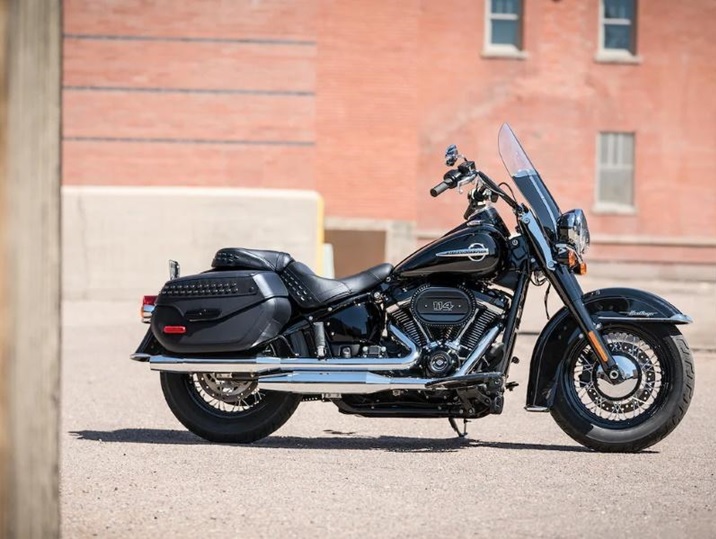
Cruiser
It is designed to cover long distances at medium cruising speeds without modifications, they are the basis of almost all other types of Custom, excluding cafe racers, street fighters, or some specials.
Its morphology corresponds to a long and low motorcycle with a large wheelbase, wide handlebars, a large capacity tank, and enveloping fenders. The riding position it presents is relaxed with the back straight or slightly leaned back, the arms relaxed, and the legs extended forward. They usually have foot platforms instead of footpegs, and windshields and leather saddlebags or hard cases are often added.
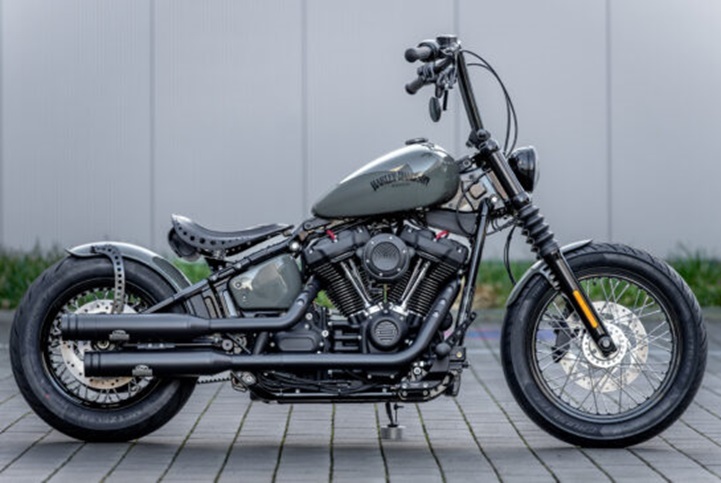
Bobber
They appeared in the 1940s and are generally created from motorcycles of brands present at the time in the United States and Great Britain, such as Harley Davidson, Indian, and Triumph mainly.
They were initially created by American soldiers returning home after fighting in Europe and are characterized by being low and long, type long and low. They have two wheels of equal diameter and usually the same thickness, they may have whitewall tires and classic spoked rims. The front fenders are removed, the rear ones are modified to accommodate a small single seat, and the exhaust pipes are changed or simplified, then wrapped in asbestos tape.
The original chassis is not modified, but the double delta type is preferred. As for the handlebars, there are several trends, such as wide "Flier" types, high "Ape Hanger" types of medium height, and short and straight ones.
The paint, mechanical details, and accessories are customized to the taste of the rockers of the time, using colors like black and maroon, predominantly matte, with some airbrushing featuring themes primarily from World War II bombers like Nose Art and Pin Up, Rock and Roll, and Blues.
Bobbers are the predecessors of choppers and there are various classifications based on the shape and length of the rear fender, the size of the tank, and the height of the chassis in relation to the ground.
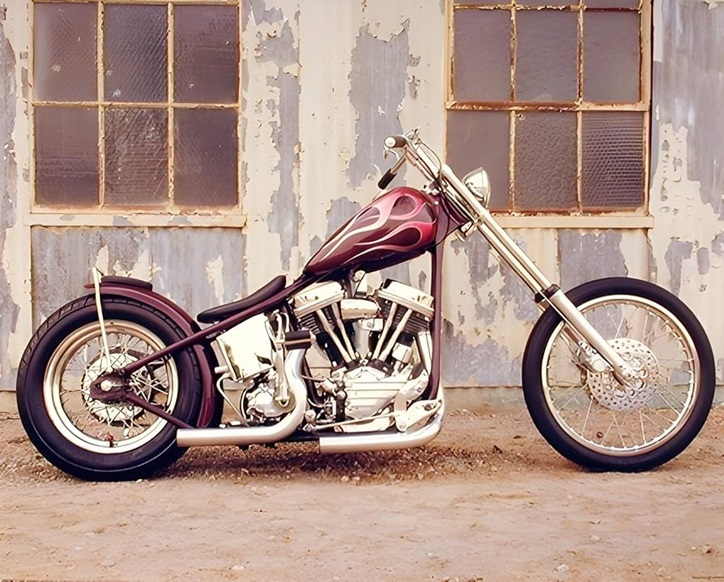
Chopper
From the name "chop," as everything deemed superfluous is cut or dismantled, they emerged in the late 1960s in the United States and are characterized by being thin, low at the back, and high at the front, with very long forks, a thin front wheel, and a much thicker rear wheel.
The chassis is modified, and in some cases, a chassis specifically created to convert the motorcycle into a chopper is installed. The original handlebars are often replaced with "ape hangers," although they can also be straight and low handlebars in instances where the chassis leaves the towers that hold the handlebars at a greater height.
There are nuances, particularly with the type of handlebars and the fork's rake angle, but basically, their characteristics are narrow and long chassis that are much higher in the front than in the back, relatively small fuel tanks compared to a stock motorcycle, lowered or even nonexistent rear suspension with a rigid chassis, long forks, and often springer-type spring suspensions. The paint is usually striking, with abundant chrome and shine, and airbrushing is very present throughout the motorcycle.
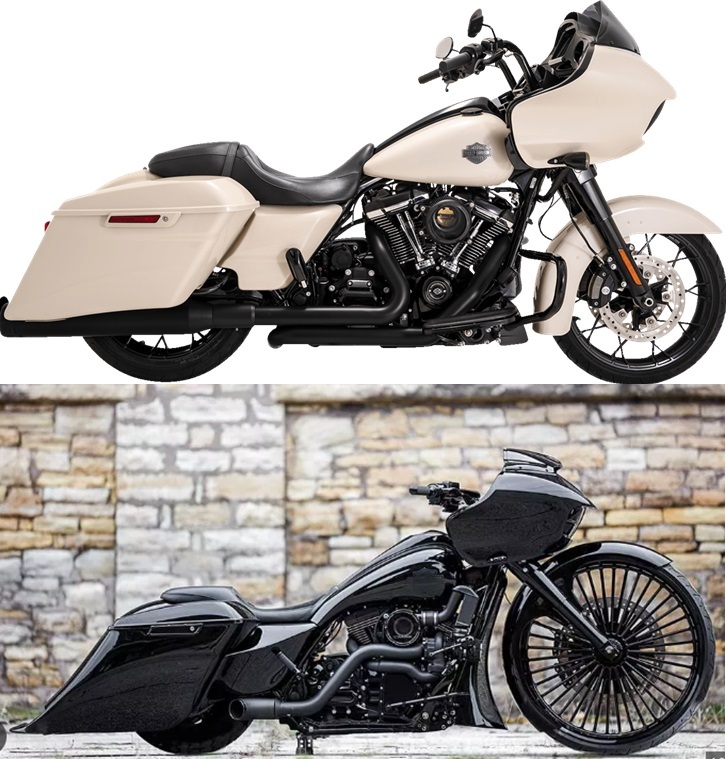
Dresser and Bagger
They appeared in the mid-1960s, simultaneously in the United States and Great Britain. Their name comes from the English "to dress" and "bags," as they typically have saddlebags for clothing or accessories for a trip.
This is the least aggressive type of customization on the original model, as, unlike other styles, it involves either replacing parts and accessories of the motorcycles with others that have better aesthetics or simply adding parts both to incorporate new functionalities and to change their appearance to a more touring style, regardless of whether long trips are made with the motorcycle or not. All parts that can be chrome-plated are usually chromed, and bright colors and high-level airbrush artwork are generally used.
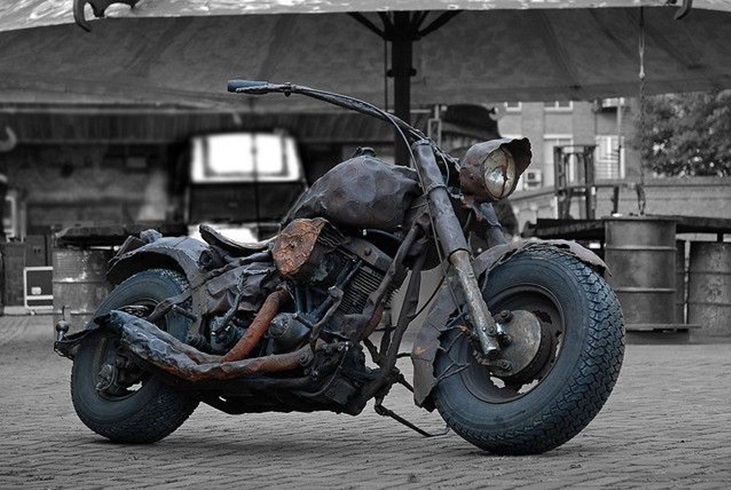
Rat Bike
It consists of modifying or creating motorcycles from old scrap parts, rusty accessories from machines unrelated to motorcycling, making the motorcycle function correctly but with a decadent, dirty, and old appearance.
Matte black or military green paint is used, and all chrome is completely eliminated; at times, some builders have gone so far as to create rust to apply to some of their parts.
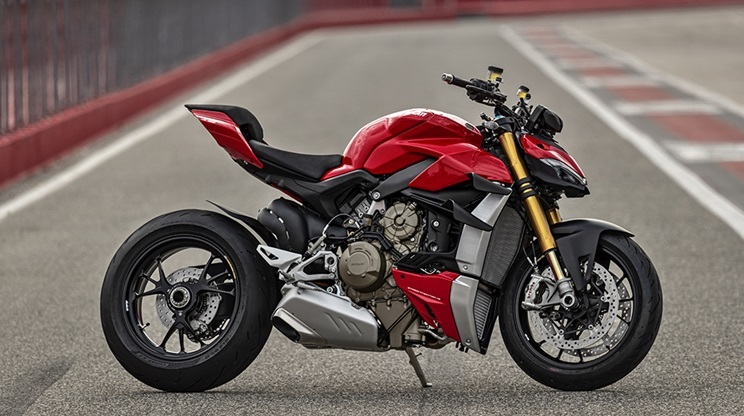
Street Fighter
The urban warrior is different from other customs because the base used is a sportbike, usually Japanese and, in some cases, Italian. They appeared in Great Britain in the late 1980s in the most congested urban traffic cities and quickly spread to Europe, especially Germany.
Modern materials such as fiberglass, carbon fiber, and aluminum are used, modifying both the aesthetics and mechanics of the bike to the point of providing superior performance.
They are aesthetically characterized by having the rear elevated at a very exaggerated angle, as they are always single-seaters, exposing thick rear tires and powerful exhaust pipes. The fairings are removed, and some parts are polished or chromed. The headlights are replaced with much smaller and more sophisticated ones, and often bubble-shaped windshields are installed over them, resembling faces with luminous eyes. The colors range from the most delirious airbrush designs to the most sinister ones.
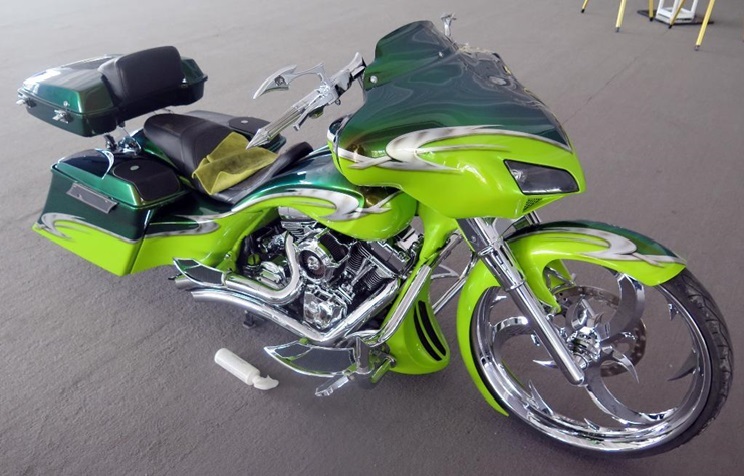
Show Bike
They are usually created with the sole purpose of being presented at competitions where builders are awarded for their works; they are not typically designed to be used as vehicles, although it is always an essential requirement that the bikes start and are capable of functioning correctly. Often, they are created to promote their products.
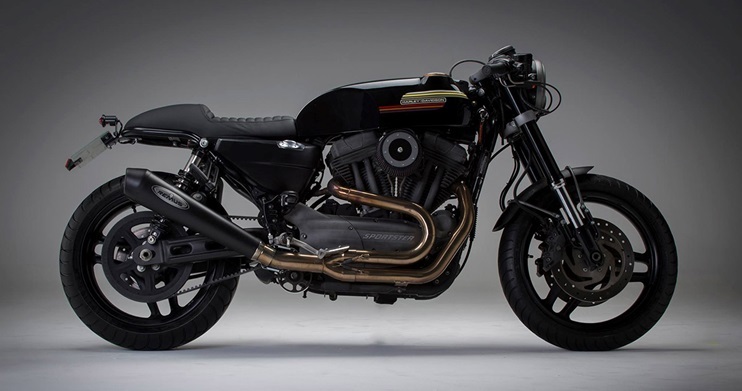
Cafe Racer
They have characteristics of racing motorcycles from the 1930s to 1950 in Europe, are taller than cruisers, with straight handlebars that are not very long, short front end, a forward-leaning riding position to better cut through the air, a flat seat for 1 or 2 passengers positioned higher than the low seat of cruiser motorcycles, a single large round headlight, and spoke or paddle wheels.
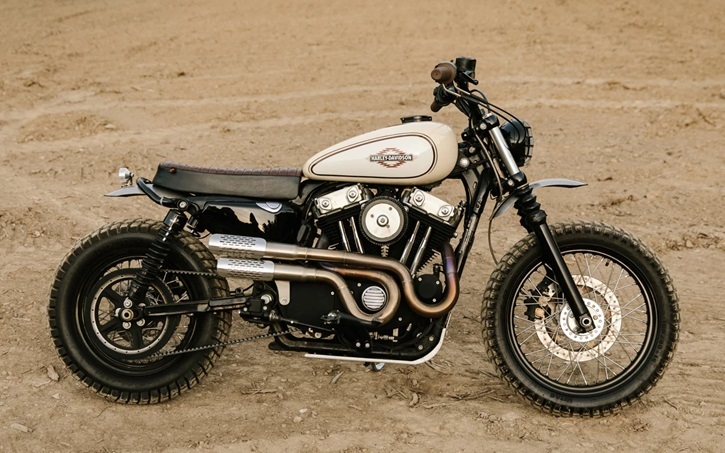
Scrambler
Motorcycles with a classic European style from the 1930s to 1950s, of medium height like cafe racers but adapted for paved roads with off-road capability.
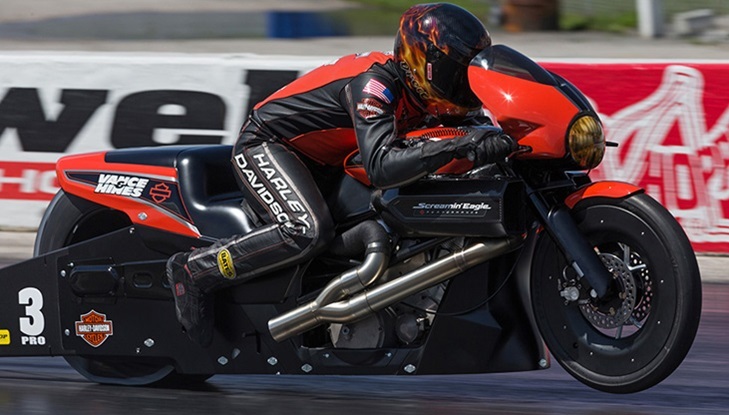
Drag Style
Designed primarily for drag racing, very popular in Europe, it has a long chassis, very wide rear tire, and low center of gravity, high gear ratio with low torque for great initial acceleration, low and straight handlebars, forward seat, small fuel tank, and large exhaust pipes usually chrome-plated.
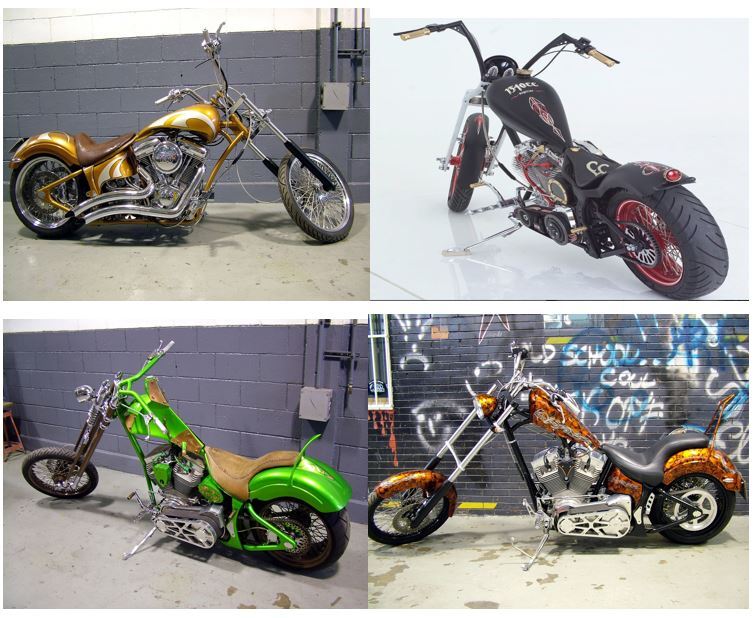
Special Construction
At the beginning of the 21st century, a new trend emerged in countries such as Venezuela, Mexico, the USA, Hungary, Germany, Japan, and South Africa. Its structure adheres to a standardized inclination of 38 to 42 + 3 degrees on the saddle support, depending on the model being developed.
This trend does not base itself on a stock motorcycle, as there is no brand or original model, except for the engine; rather, the motorcycle is built entirely from scratch, starting with a custom-made chassis tailored to the customer's specifications.
It is the evolution of show bikes, as special constructions are designed to be showcased at events but also to be roadworthy. They must comply with international regulations such as strict adherence to SAE standards and possess a WFI (World Manufacturer's Identification), since, despite being unique motorcycles, they must meet international quality and safety standards.
Manufacturing is highly customized, with each part of the motorcycle crafted piece by piece. There are companies in various countries, such as Dajoma Motor World in Venezuela, East Coast Choppers in the USA, and Beey Motorcycle in Mexico, among others, that are pioneers in this production, investing around four months to build each motorcycle. They incorporate innovations like handmade stainless steel fuel tanks, stainless steel exhausts, among other features.
The main goal of these motorcycles is to maintain the essence of the movement, being a true ally of rock blues and freedom while ensuring that just as you are unique, your motorcycle is as well.
These motorcycles are primarily manufactured in the previously mentioned Chopper and Pro Street styles, with rear tires ranging from 250 to 360 millimeters, and engines capable of delivering 120 hp and 124 lb of torque, with the capacity to reach 300 km/h using the 2000 cc Screaming Eagle engine.
Their main competition is the so-called World Championship of Custom Motorcycle Builders, where the top builders of this custom motorcycle trend gather to showcase and compete in development, creativity, and functionality. However, these motorcycles are often out of reach for most people, as the cost is usually prohibitive—not only due to the exclusivity of the engineering project, the time spent by various artisans and teams of mechanics, the use of high-quality materials, but also due to the bureaucratic infrastructure required to legally put them on the road and the numerous procedures that must be completed for their homologation.
When World War II broke out, there were two motorcycle manufacturing brands in the United States that produced models for the police and the military Harley Davidson and Indian.
However, it was Harley that benefited from the conflict, signing a contract with the army that gave them exclusivity during the war. Consequently, thousands of Harley Davidson motorcycles were manufactured for the battlefield. However, when the war ended, there was a surplus of units that were resold to soldiers returning from Europe at a symbolic price. The young men returning from the harsh realities they experienced brought with them a means of transportation, as well as objects, clothing, and symbols taken from the German enemy, into the prim and proper American society.
A phenomenon of rebellion began to emerge among these discontented youths, who gradually formed motorcycle gangs to have fun, escape, and rebel. Many of them modified their bikes, enhancing and improving them, thus creating the first customs. Some groups adorned themselves with symbols of the German army, such as iron crosses and imperial eagles, as a display of pride for having fought, as well as rebellion, identification, and reaffirmation as a group—also a way to shock society. Rhythms and sounds deemed socially inappropriate, such as boogie and swing among others, began to become part of the nascent popular culture of these young people.
By the 1950s, rock and roll, with its rhythms, caught the attention of many young people who continued to use motorcycles as their means of transportation, taking the baton from the previous post-war generation. It was here that the unbreakable bond between customs and rock truly formed, a connection that has accompanied the movement up to the present day. This is also when what would later be called Kustom Kulture (spelled with a "K") emerged.
In the '60s and '70s, customs became a way of life. Groups of motorcyclists traveled across the United States on their customized bikes, evading the control of authorities. The movement grew stronger, influenced not only by music but also by new currents among youths increasingly discontent with their government, always seeking an utopian Freedom.
In the following decades, largely thanks to film and music, "kustom kulture" expanded worldwide, catching the eye of the industry and establishing itself as a style of bike that will never disappear, as it continues to captivate millions of people generation after generation.




Jorge "George" ICS MasterMechanic

Daniel "RoadRatDan" Harley Davidson Historian